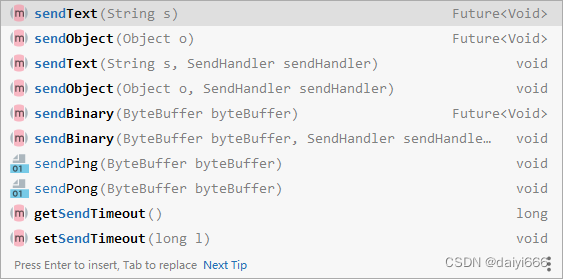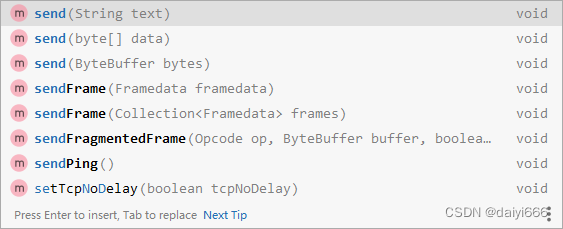環(huán)境信息
| 名稱 | 版本號(hào) |
|---|---|
| Spring Boot | 2.4.5 |
| Idea | 2021.3.2 |
服務(wù)端實(shí)現(xiàn)
導(dǎo)入依賴
<dependency>
<groupId>org.springframework.boot</groupId>
<artifactId>spring-boot-starter-websocket</artifactId>
</dependency>
注意:Spring Boot在父工程中已經(jīng)管理了websocket的版本信息,所以不用指定版本號(hào)也是可以的
創(chuàng)建配置類
package com.fenzhichuanmei.configuration;
import org.springframework.context.annotation.Bean;
import org.springframework.context.annotation.Configuration;
import org.springframework.web.socket.server.standard.ServerEndpointExporter;
/**
* @author Yi Dai 484201132@qq.com
* @since 2022/5/13 11:34
*/
@Configuration
public class WebsocketConfiguration {
@Bean
public ServerEndpointExporter serverEndpointExporter() {
return new ServerEndpointExporter();
}
}
創(chuàng)建此配置類的目的只是為了把ServerEndpointExporter 這個(gè)類的實(shí)例交給spring 容器進(jìn)行管理,您可以用任意一種方式交給容器,如使用@Import(ServerEndpointExporter.class)這種方式等進(jìn)行操作;此處只是我的編碼風(fēng)格如此;并非必須這樣操作
創(chuàng)建一個(gè)注解式的端點(diǎn)并在其中通過配套注解聲明回調(diào)方法
package com.fenzhichuanmei.websocket;
import com.fenzhichuanmei.websocket.utils.SessionManager;
import lombok.extern.slf4j.Slf4j;
import org.springframework.stereotype.Component;
import javax.annotation.Resource;
import javax.websocket.*;
import javax.websocket.server.PathParam;
import javax.websocket.server.ServerEndpoint;
/**
* @author Yi Dai 484201132@qq.com
* @since 2022/3/7 15:47
*/
@Slf4j
@Component
@ServerEndpoint("/arcticFoxServerEndpoint/{websocketClientType}")
public class ArcticFoxServerEndpoint {
private static SessionManager sessionManager;
@Resource
public void setProcessor(SessionManager sessionManager) {
ArcticFoxServerEndpoint.sessionManager = sessionManager;
}
/**
* 建立連接成功的回調(diào)方法
*
* @param session 會(huì)話對(duì)象
* @param websocketClientType 此參數(shù)就是路徑中{websocketClientType}位置傳入的參數(shù)
*/
@OnOpen
public void onOpen(Session session, @PathParam("websocketClientType") int websocketClientType) {
sessionManager.onOpen(session, websocketClientType);
}
/**
* 當(dāng)會(huì)話關(guān)閉時(shí)執(zhí)行的回調(diào)方法
*
* @param session 會(huì)話對(duì)象
* @param websocketClientType 此參數(shù)就是路徑中{websocketClientType}位置傳入的參數(shù)
*/
@OnClose
public void onClose(Session session, @PathParam("websocketClientType") int websocketClientType) {
sessionManager.onClose(session, websocketClientType);
}
/**
* 當(dāng)收到客戶端信息時(shí)執(zhí)行的回調(diào)方法
*
* @param session 會(huì)話對(duì)象
* @param message 客戶端傳遞過來的信息
* @param websocketClientType 此參數(shù)就是路徑中{websocketClientType}位置傳入的參數(shù)
*/
@OnMessage
public void onMessage(Session session, String message, @PathParam("websocketClientType") int websocketClientType) {
sessionManager.onMessage(session, message, websocketClientType);
}
/**
* 當(dāng)發(fā)生錯(cuò)誤時(shí)的回調(diào)方法
*
* @param session 會(huì)話對(duì)象
* @param e 異常對(duì)象
* @param websocketClientType 此參數(shù)就是路徑中{websocketClientType}位置傳入的參數(shù)
*/
@OnError
public void onError(Session session, Throwable e, @PathParam("websocketClientType") int websocketClientType) {
sessionManager.onError(session, e, websocketClientType);
}
}
@ServerEndpoint注解標(biāo)注此類為一個(gè)服務(wù)端的端點(diǎn)類,此注解有一個(gè)必須的參數(shù),用于指定客戶端訪問的地址,本案例中為:/arcticFoxServerEndpoint,而路徑后面的/{websocketClientType}這個(gè)是路徑中參數(shù)的占位符,有點(diǎn)類似與Spring Mvc中Rest接口和@PathVariable注解的作用
注意事項(xiàng): 一定要將此類交給spring 容器進(jìn)行管理!!還有一個(gè)坑就是,此類的實(shí)例時(shí)非單例的,所以如果要在此類中注入其他的bean,不能使直接在屬性上使用@Resource注解或者@Autowired等注解進(jìn)行注入,否則會(huì)報(bào)錯(cuò)。正確操作應(yīng)該是把要注入的字段設(shè)置為靜態(tài)的,然后通過非靜態(tài)的set方法進(jìn)行注入,具體代碼請(qǐng)看上方實(shí)例
服務(wù)端主動(dòng)發(fā)送消息給客戶端
通過上面的代碼我們可以知道每個(gè)回調(diào)方法中都會(huì)收到一個(gè)Session對(duì)象,正如您所想,要向客戶端發(fā)送消息正是要借助此對(duì)象;Session對(duì)象有一個(gè)getAsyncRemote方法,調(diào)用此方法可以得到一個(gè)RemoteEndpoint.Async對(duì)象,查看此對(duì)象,發(fā)現(xiàn)有很多send打頭的方法;

是的,這些方法就是發(fā)送消息的方法,博主這個(gè)項(xiàng)目中主要是通過JSON來進(jìn)行交互的,所以我使用了sendText方法,示例代碼:
RemoteEndpoint.Async asyncRemote = session.getAsyncRemote();
asyncRemote.sendText(jsonString);
很顯然中轉(zhuǎn)變量asyncRemote 沒什么太大的用處,不如直接寫成:
session.getAsyncRemote().sendText(jsonString);
通過方法名看到,似乎還可以發(fā)送對(duì)象,二進(jìn)制序列等,博主沒有深入研究,有興趣的小伙伴可以嘗試嘗試
客戶端實(shí)現(xiàn)
一般來講客戶端應(yīng)該是用Java Script實(shí)現(xiàn),但是博主這個(gè)項(xiàng)目比較特殊,需要用Java來實(shí)現(xiàn)客戶端,下面博主先以Java客戶端說明其實(shí)現(xiàn)細(xì)節(jié),然后再說再前端如何實(shí)現(xiàn)
Java客戶端實(shí)現(xiàn)
導(dǎo)入依賴
<dependency>
<groupId>org.java-websocket</groupId>
<artifactId>Java-WebSocket</artifactId>
<version>1.5.3</version>
</dependency>
其實(shí)Java中實(shí)現(xiàn)WebSocket的第三方包還有很多,博主這個(gè)地方使用的是Java-WebSocket,有興趣的小伙伴可以試試其他的包
建立連接和處理回調(diào)
package com.fenzhichuanmei.websocket;
import com.fasterxml.jackson.core.JsonProcessingException;
import com.fasterxml.jackson.databind.ObjectMapper;
import com.fenzhichuanmei.components.PaymentComponent;
import com.fenzhichuanmei.pojo.Instructions;
import com.fenzhichuanmei.utils.WebsocketClientType;
import lombok.Data;
import lombok.extern.slf4j.Slf4j;
import org.java_websocket.client.WebSocketClient;
import org.java_websocket.enums.ReadyState;
import org.java_websocket.handshake.ServerHandshake;
import org.springframework.boot.context.properties.ConfigurationProperties;
import org.springframework.stereotype.Component;
import javax.annotation.Resource;
import java.net.URI;
import java.net.URISyntaxException;
/**
* @author Yi Dai 484201132@qq.com
* @since 2022/5/13 10:16
*/
@Slf4j
@Component
public class ArcticFoxWebSocketClient {
@Resource
private ObjectMapper objectMapper;
@Resource
private PaymentComponent paymentComponent;
@Resource
private ArcticFoxWebSocketClientProperties properties;
public void establishConnection() throws URISyntaxException {
WebSocketClient webSocketClient = new WebSocketClient(new URI(String.format("%s/%d", properties.getWebSocketServerUrl(), WebsocketClientType.PAYMENT_DEVICE))) {
@Override
public void onOpen(ServerHandshake serverHandshake) {
log.info("WebSocketClient: onOpen : {}", serverHandshake);
}
@Override
public void onMessage(String jsonString) {
try {
Instructions instructions = objectMapper.readValue(jsonString, Instructions.class);
if (instructions.getType() == Instructions.NOTICE_PAYMENT) {
paymentComponent.queryAnUnpaidOrdersAndPay();
} else {
throw new RuntimeException("錯(cuò)誤的指令類型");
}
} catch (JsonProcessingException e) {
e.printStackTrace();
}
}
@Override
public void onClose(int i, String s, boolean b) {
log.info("WebSocketClient: onClose : i:{},s:{},b:{}", i, s, b);
try {
Thread.sleep(1000 * 20);
establishConnection();
} catch (InterruptedException | URISyntaxException e) {
e.printStackTrace();
}
}
@Override
public void onError(Exception e) {
log.error("WebSocketClient: onError {}", e.getMessage());
}
};
webSocketClient.connect();
while (!(webSocketClient.getReadyState() == ReadyState.OPEN)) {
try {
Thread.sleep(1000 * 2);
} catch (InterruptedException e) {
e.printStackTrace();
}
}
log.info("WebSocketClient: connection established successfully");
}
@Data
@Component
@ConfigurationProperties("arctic-fox-web-socket-client.properties")
public static class ArcticFoxWebSocketClientProperties {
private String webSocketServerUrl;
}
}代碼解釋: 其實(shí)我的establishConnection方法中上來就實(shí)例化了一個(gè)WebSocketClient 類的實(shí)例,請(qǐng)注意,此類是個(gè)抽象類,我在這里用匿名實(shí)現(xiàn)類的方式實(shí)現(xiàn)的,此類有幾個(gè)抽象方法需要實(shí)現(xiàn),也就是onOpen,onMessage,onClose,onError四個(gè)方法,其作用其實(shí)已經(jīng)是很見名知意了,和服務(wù)端的回調(diào)方法一樣,就不過多解釋;實(shí)例化此類需要傳入一個(gè)URI對(duì)象,這個(gè)URI對(duì)象其實(shí)就是封裝了對(duì)服務(wù)端連接的地址,由于博主不希望把服務(wù)端的地址給寫死了,所以我配置到了配置文件中,然后通過String.format靜態(tài)方法配合占位符拼接url地址和參數(shù);路徑的規(guī)則是:協(xié)議名://IP地址(或域名):端口號(hào)/服務(wù)端聲明的地址/參數(shù);舉個(gè)例子:
ws://192.168.88.88:8080/arcticFoxServerEndpoint/1
ws://localhost:8080/arcticFoxServerEndpoint/2
ws://為協(xié)議;實(shí)例化WebSocketClient 類的實(shí)例之后,調(diào)用其connect()方法即開始建立連接,調(diào)用getReadyState()方法可以獲得其狀態(tài);由于我的服務(wù)端可能隨時(shí)都連不上,所以我在客戶端的onClose回調(diào)函數(shù)中進(jìn)行了一個(gè)遞歸(20秒后),用于重新連接。
客戶端向服務(wù)端發(fā)送消息
通過WebSocketClient 類的實(shí)例,我們可以看到有以下方法,很明顯send方法就是用來發(fā)送消息使用的

示例代碼:
//判斷一下是否為空
if (Objects.nonNull(webSocketClient)) {
try {
//通過jackson將對(duì)象轉(zhuǎn)換為json字符串(非必須)
String jsonString = objectMapper.writeValueAsString(feedback);
//發(fā)送信息
webSocketClient.send(jsonString);
} catch (JsonProcessingException e) {
e.printStackTrace();
}
} else {
log.warn("no connection established");
}
在前端環(huán)境(vue)中使用websocket
安裝reconnecting-websocket包(非必須)
npm i --save reconnecting-websocket安裝這個(gè)包是為了websocket能在斷線之后重新連接,其實(shí)不使用這個(gè)包也是可以用原生Java Script實(shí)現(xiàn)的;但是他和原生的api幾乎一樣;
示例代碼:
import ReconnectingWebSocket from "reconnecting-websocket";
export default function initializationWebsocket() {
let reconnectingWebSocket = new ReconnectingWebSocket(`ws://localhost:8080/arcticFoxServerEndpoint/${2}`);
reconnectingWebSocket.onopen = event => {
console.log("on open :", event);
};
reconnectingWebSocket.onmessage = event => {
//event對(duì)象中data存儲(chǔ)的就是服務(wù)端發(fā)送過來的消息
let parse = JSON.parse(event.data);
console.log("webSocket on message :", parse);
};
reconnectingWebSocket.onclose = event => {
console.log(event);
};
reconnectingWebSocket.onerror = event => {
console.log(event);
};
//窗口關(guān)閉時(shí)斷開連接
window.onbeforeunload = function () {
reconnectingWebSocket.close();
}
}
在前端中實(shí)現(xiàn)websocket就比較簡單了,就上面的幾行代碼即可,不用調(diào)用其他函數(shù)進(jìn)行連接,實(shí)例化之后就開始連接了
想服務(wù)端發(fā)送信息
在前端中發(fā)送信息就更簡單了,直接調(diào)用reconnectingWebSocket的send方法,傳入要發(fā)送的數(shù)據(jù)即可
到此這篇關(guān)于SpringBoot+WebSocket實(shí)現(xiàn)即時(shí)通訊的方法詳解的文章就介紹到這了,更多相關(guān)SpringBoot WebSocket即時(shí)通訊內(nèi)容請(qǐng)搜索html5模板網(wǎng)以前的文章希望大家以后多多支持html5模板網(wǎng)!
